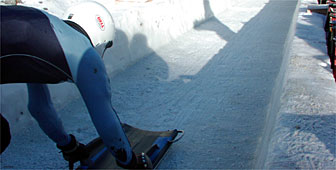Nuts and bolts of the notorious Cresta Run

The easiest way to recognise a hardened rider of the Cresta Run is to look at his X-ray.
Retired Lieutenant-Colonel Digby Willoughby, secretary of the St Moritz Tobogganing Club, asks the beginners’ group to take a close look at the X-ray skeleton hanging from the wall. “Gentlemen, these three bits of metal are three of the five that still connect my head to my body.”
The X-ray is a montage of bones from members of the club’s executive committee as well as the screws, nuts and bolts that hold them together.
Hardened toboggan riders on St Moritz’ legendary Cresta Run hurtle down the track on their bellies, head first, reaching speeds up to 130 kilometres per hour. Many hurt themselves.
Unlike a bobsleigh course, not all the curved banks of the Cresta Run are built high enough to prevent riders from exiting the icy track when they fail to negotiate the right line.
Tweed and cashmere
Some do it in tweed trousers and cashmere jumpers. Some are overweight or well past their prime. Others are beginners, who have forked out SFr450 ($270) for the chance to don old leather knee and elbow pads, and put on ice skates with forked toe spikes replacing the blades. All are amateurs.
Following Willoughby’s parting words, “Remember, you are here to enjoy yourselves and not damage yourselves,” the beginners, or Supplementary Members as they are called, follow their appointed “guru” for further instruction.
“It happens half a dozen times a season,” warns guru Paul Glander about the dangers of getting a finger caught under the toboggan runners, “somebody takes off their glove and a finger stays inside. It can be sewed back on, but it’ll never be any good for picking your nose again.”
Despite the injuries, there have been few deaths in the 117 years of the Cresta Run’s existence. Set up by British tourists and St Moritz hoteliers in 1885, it was the first competitive toboggan run in Europe.
It spawned the bobsleigh, which has outgrown it in popularity, but not in eccentricity.
European aristocrats
It is still lorded over by English gentlemen and European aristocrats. It is a private club and women, children and pets are not allowed.
A Union Jack proudly flutters in the breeze above the clubhouse where German and Italian is spoken as much as English.
The Austrian-German national, Arnold von Bohlen und Halbach, is the club’s vice-president and well represented on the X-ray, having broken both femurs, his collarbone, an arm and shoulder and countless fingers and ribs.
“You have to expect to get some bruises,” says the 62-year-old von Bohlen und Halbach nonchalantly. “It’s part of the sport.”
“It was my idea to provide instruction for the beginners,” he says. “The year I broke one of my femurs I still wanted to do something in the club so I took over beginners and told them how to ride, or not to ride.”
Von Bohlen und Halbach has been coming to St Moritz since 1956 to ride the Cresta Run.
A 55-year-old French-American doctor, Jean Noël Prade, says he intends to ride long enough to break the age record set by an 83-year-old.
The attraction of the Cresta Run, Prade says, is “adrenalin and speed and you don’t get slower the older you get, which is one of the few sports where that is possible.”
Both Prade and von Bohlen und Halbach wear skin-tight lycra suits while other members favour 19th century Victorian fashion.
“I’m wearing a nice cashmere jumper with tweed plus twos, as they call them, and knee high socks,” says new member Oliver Jones. “I’ve got club rakes, which are racing shoes, then I wear leather pads on my knees and elbows and metal gauntlets over my gloves.”
Also looking very Victorian is Swiss member Benno Hafner. “I started wearing traditional gear, and I don’t want to change,” he says. “I don’t care if I’m a second faster or not.”
Speed alone no longer appeals to Willoughby who presides over the race proceedings from his vantage point high above the track in the clubhouse tower.
Shuttlecock Club
He scolds beginners over the loudspeaker for going faster than they should have, comments on riders’ dress as they prepare to start, and if a rider goes out at the notorious corner known as Shuttlecock, welcomes him to the “Shuttlecock Club”.
That is, if he follows Willoughby’s precise instructions after the spill: “Face the clubhouse and rise to your feet,” Willoughby says in his introductory lecture.
“Only then do I know that neither of your legs is broken. Then I want both arms in the air and to cross your chest. Only then do I know that your upper arms and shoulders are alright and you are capable of taking your toboggan out of the way, because you are wasting our time down there.”
“I still have a lot of fun and go down a bit more slowly,” says von Bohlen und Halbach.”
“Is it masochism? I don’t know,” adds Prade, before heading out of the clubhouse for yet another ride on the Cresta Run.
by Dale Bechtel

In compliance with the JTI standards
More: SWI swissinfo.ch certified by the Journalism Trust Initiative

You can find an overview of ongoing debates with our journalists here. Please join us!
If you want to start a conversation about a topic raised in this article or want to report factual errors, email us at english@swissinfo.ch.